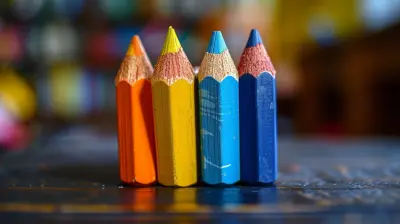How to Use Mnemonics for Effective Memorization
2 July 2025
Ever feel like your brain is a leaky bucket when it comes to remembering information? You cram for hours, only to forget half of it the moment you close your notes. Well, you're not alone. But what if I told you there’s a fun, simple, and brain-hacking way to remember more using less effort? Enter mnemonics — basically your brain’s cheat codes.
Let’s deep-dive into how mnemonics can be your secret weapon for effective memorization, whether you're a student, a professional, or just someone trying to keep track of life.
What Are Mnemonics Anyway?
Mnemonics (pronounced "nuh-MON-iks") are memory aids — tools that help you remember things more easily. Think of them as mental shortcuts or, better yet, memory glue. They stick information to your brain by associating it with something more familiar or catchy.For example, you probably already know some mnemonics without even realizing it:
- “PEMDAS” for the order of operations in math (Parentheses, Exponents, Multiplication, Division, Addition, Subtraction)
- “Every Good Boy Deserves Fudge” for the lines on a treble clef in music
- ROYGBIV to remember the colors of the rainbow
Yep, all those catchy phrases and acronyms? Mnemonics in action.
Why Do Mnemonics Work So Well?
Before we talk techniques, let’s understand why mnemonics are so effective. Our brains are wired to remember certain types of information better than others. Think vivid images, stories, emotions, rhymes — all of which mnemonics tap into.Here’s what happens: when you use a mnemonic, you’re linking new info (something unfamiliar) with something your brain already knows well or processes easily. This connection acts like a bridge — much easier to walk across than swimming through a sea of boring facts.
It's like trying to remember a long number versus remembering your best friend’s phone number set to a catchy tune. One sticks, the other slips away.
The Main Types of Mnemonics You Can Use
There isn't just one way to create a mnemonic. Different styles work better depending on what you're learning. Here are the most powerful types:1. Acronyms and Acrostics
These are probably the most common.- Acronym: A word made from the first letters of a series of words. Think NASA (National Aeronautics and Space Administration).
- Acrostic: A memorable phrase where the first letter of each word stands for something else. Like “My Very Educated Mother Just Served Us Nachos” for the planets of the solar system.
These are handy for memorizing ordered lists, formulas, processes, etc.
2. Visualization Mnemonics
This is where you turn boring facts into mental images. The weirder or more dramatic, the better.Trying to remember that "stalactites" hang from the ceiling, and "stalagmites" grow from the ground? Picture tightrope walkers balancing on stalactites and mites crawling up from the cave floor.
The mind loves visuals — especially ones that evoke an emotion or action.
3. Rhymes and Songs
Turn your facts into a jingle! Rhyming phrases stick better because of the rhythm and melody. Remember this classic?> “In fourteen hundred ninety-two, Columbus sailed the ocean blue.”
You can even make up your own beats. Grammar rules, historical dates, or even complex equations sound way better when they rhyme.
4. Chunking
Breaking info into manageable parts or “chunks.” Our brain loves to process info in limited bites.Instead of trying to remember 7423196542, you chunk it: 742-319-6542. Ah, much easier.
Useful for phone numbers, dates, or sequences.
5. Memory Palace (Method of Loci)
This one’s a bit more advanced — and powerful.You imagine a place you know well (like your house) and place visual representations of the info you want to remember in different spots throughout the place. Then when it’s recall time, you mentally walk through your Memory Palace picking up facts as you go.
Pretty cool, right? Ancient Greeks used this technique to remember entire speeches! It's especially handy for long lists or complex info.
How To Create Your Own Mnemonics Step-by-Step
Let’s not just talk theory. Let’s build one right now.Step 1: Identify the Info You Need to Remember
Let’s say you're trying to memorize the biological classification system:Kingdom, Phylum, Class, Order, Family, Genus, Species
Step 2: Choose a Type of Mnemonic
An acrostic works great here.Step 3: Create a Memorable Phrase
How about:> “King Philip Came Over For Great Spaghetti”
Silly? Yes. But the best mnemonics are.
Step 4: Picture It!
Now imagine King Philip literally stepping over a plate of steaming spaghetti. Sounds weird — but that’s the point.The stronger the image, the better the memory.
Real-Life Examples of Mnemonics in Action
Let’s look at a few practical cases:For Studying Languages
Trying to remember that the Spanish word for "bread" is "pan"? Imagine a frying pan full of toasted bread. Boom — instant connection.For Medical Students
To memorize the cranial nerves:> “Oh, Oh, Oh, To Touch And Feel Very Green Vegetables – AH!”
Each letter stands for a nerve in order. It’s fun, memorable, and way better than brute-force repetition.
For Exam Prep
Need to remember the causes of the French Revolution?> Use a rhyme or acronym tied to the major causes — like “STAMP” (Social inequality, Tax burden, Absolute monarchy, Money crisis, Privilege system)
Tips for Making Your Mnemonics Stick
✔️ Make it Personal – Tie it to your own experiences or interests.✔️ Use Humor or Emotion – Funny or emotional content is more memorable.
✔️ Keep It Visual and Weird – The stranger your mental image, the more likely it’ll stick.
✔️ Say It Out Loud – Auditory reinforcement helps. Sing it, shout it, recite it in the shower.
✔️ Practice Retrieval – Don't just read your mnemonics — test yourself.
✔️ Teach It to Someone Else – If you can explain it, you know it.
Common Mistakes to Avoid
Even though mnemonics are awesome, there are a few pitfalls.- Overcomplicating It: Don’t try to cram too much into one mnemonic. Keep it short and sweet.
- Forgetting the Actual Info: Mnemonics are a tool, not the end goal. Always connect them back to the real material.
- Not Reviewing: Just like muscles, memory needs exercise. Without repetition, even the catchiest phrase can fade.
When Should You Use Mnemonics?
Good question.Mnemonics shine best when:
- You’re dealing with lists, sequences, formulas, or foreign vocabulary
- You need to memorize something quickly
- You’re struggling with dry or abstract info
They're probably less useful for things like conceptual understanding or open-ended problem-solving — but great as a supplement.
Final Thoughts: Are Mnemonics Really Worth It?
Absolutely — but like any tool, it depends how you use them. Mnemonics aren’t magic on their own. They work best when combined with understanding, repetition, and active recall.Think of mnemonics as the GPS for your memory. It won’t drive the car for you, but it’ll definitely keep you from getting lost.
So next time you're buried in facts to memorize, don’t panic — get mnemonic.
Happy memorizing!
all images in this post were generated using AI tools
Category:
Test PreparationAuthor:

Olivia Lewis
Discussion
rate this article
2 comments
Cara Smith
Great tips! Mnemonics really transform memorization into a breeze.
November 22, 2025 at 3:23 AM

Olivia Lewis
Thank you! I'm glad you found the tips helpful. Mnemonics can truly make memorization much easier!
Celeste Reese
Mnemonics simplify memorization; they make learning fun and effective!
July 17, 2025 at 3:51 AM

Olivia Lewis
Thank you! I’m glad you found the article helpful. Mnemonics truly do make learning more enjoyable and memorable!


